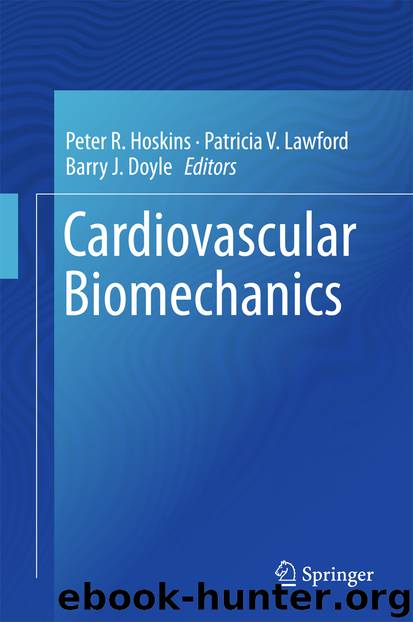Cardiovascular Biomechanics by Peter R. Hoskins Patricia V. Lawford & Barry J. Doyle

Author:Peter R. Hoskins, Patricia V. Lawford & Barry J. Doyle
Language: eng
Format: epub
Publisher: Springer International Publishing, Cham
There are various terms used in the literature including ‘experimental flow system’, ‘phantom’ and ‘flow phantom’. In this chapter, the term ‘phantom’ will be used to describe the central cardiovascular construct, and ‘flow phantom’ used to describe the entire apparatus consisting of pump, pump controller, tubing, reservoirs and the phantom. The phantom consists of components which mainly mimic 2 tissues; the blood (blood mimic) and the soft tissue (tissue mimic). For phantoms mimicking flow in vessels the soft tissue may be further divided into the artery or vein (vessel mimic) and the surrounding soft tissue consisting of fat, muscle, liver, kidney, etc. (tissue mimic).
The advantages of using a flow phantom over an in vivo experiment are: Control. High degree of control over experimental conditions including vessel geometry and flow rates.
Download
This site does not store any files on its server. We only index and link to content provided by other sites. Please contact the content providers to delete copyright contents if any and email us, we'll remove relevant links or contents immediately.
| Automotive | Engineering |
| Transportation |
Whiskies Galore by Ian Buxton(41880)
Introduction to Aircraft Design (Cambridge Aerospace Series) by John P. Fielding(33064)
Small Unmanned Fixed-wing Aircraft Design by Andrew J. Keane Andras Sobester James P. Scanlan & András Sóbester & James P. Scanlan(32743)
Craft Beer for the Homebrewer by Michael Agnew(18140)
Turbulence by E. J. Noyes(7936)
The Complete Stick Figure Physics Tutorials by Allen Sarah(7307)
Kaplan MCAT General Chemistry Review by Kaplan(6867)
The Thirst by Nesbo Jo(6828)
Bad Blood by John Carreyrou(6552)
Modelling of Convective Heat and Mass Transfer in Rotating Flows by Igor V. Shevchuk(6391)
Learning SQL by Alan Beaulieu(6211)
Weapons of Math Destruction by Cathy O'Neil(6146)
Man-made Catastrophes and Risk Information Concealment by Dmitry Chernov & Didier Sornette(5921)
Digital Minimalism by Cal Newport;(5664)
Life 3.0: Being Human in the Age of Artificial Intelligence by Tegmark Max(5474)
iGen by Jean M. Twenge(5366)
Secrets of Antigravity Propulsion: Tesla, UFOs, and Classified Aerospace Technology by Ph.D. Paul A. Laviolette(5309)
Design of Trajectory Optimization Approach for Space Maneuver Vehicle Skip Entry Problems by Runqi Chai & Al Savvaris & Antonios Tsourdos & Senchun Chai(5011)
Pale Blue Dot by Carl Sagan(4912)
